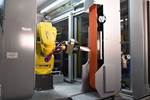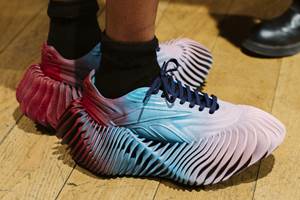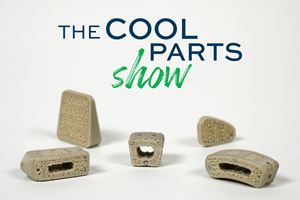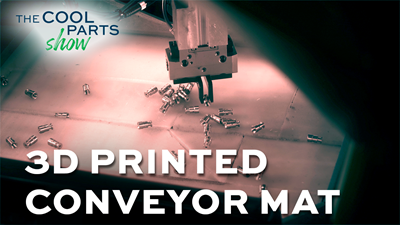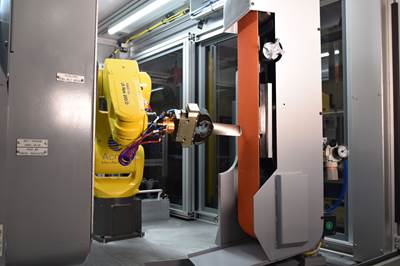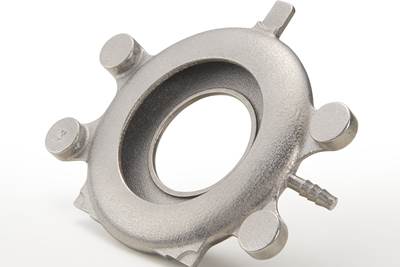Is Every 3D Printed Replacement Part Inherently an Upgrade? AM Radio #32
Additive manufacturing is a powerful tool for replacement parts, but turning to AM offers opportunities beyond recreating what came before. In this episode of the AM Radio podcast, we discuss AM for repair, replacement and upgrades.
3D printing for repair and replacement is an underappreciated but potentially very valuable application of AM technology. The ability to add material only where necessary and to do so in an automated fashion allows worn surfaces to be rebuilt with less human labor, keeping items such as aircraft blades in service longer. In addition, additive manufacturing offers an avenue for manufacturing parts no longer in inventory or production, by skipping over tooling to arrive more quickly (and often, more affordably) at the needed component — be it a brush mat, bearing housing, mixer blade, clamp or tractor tread. But a 3D printed replacement part is rarely a one-to-one swap; changing to this production method almost always introduces additional benefits. In this episode of AM Radio, Pete Zelinski and I discuss these examples and more, plus why a 3D printed replacement is almost always an upgrade.
Transcript
Stephanie Hendrixson 00:05
On today's show, we're talking about additive manufacturing to repair and replace worn, broken, discontinued and otherwise unavailable parts. And we'll consider whether every 3D printed replacement is inherently an upgrade. That's coming up on AM Radio.
Peter Zelinski 00:27
This episode of the AM Radio podcast is brought to you by PTXPO, the trade show for North American plastics professionals. Join Additive Manufacturing Media and sister brand Plastics Technology for PTXPO 2023 coming in March. Find more information at plasticstechnologyexpo.com.
Stephanie Hendrixson 00:51
Welcome to AM Radio, I'm Stephanie Hendrixson. I'm joined in the studio today by Pete Zelinski. Hi, Pete.
Peter Zelinski 00:56
Hi, Stephanie.
Stephanie Hendrixson 00:57
And today on the show, we're going to talk about kind of a big topic but kind of an underappreciated topic with additive manufacturing. And that is its use for repairing and replacing parts that are broken, worn, damaged in some way, or maybe just no longer available.
Peter Zelinski 01:14
It's a huge opportunity. And it's a great starting point for our first episode of the year because repair and replacement is frequently a starting point for succeeding with additive for advancing into its other applications. A challenge that additive often has initially is that it wants to change the design of components, it wants to realize an entirely new design that leverages the promise of additive. Applying additive manufacturing for repair replacement, this is an opportunity where the design inherently already exists, you're trying to get back to that original design. And that is another useful promise of additive.
Stephanie Hendrixson 01:58
Yeah, so I think we've definitely seen lots of examples where repair or replacement is the entry point for additive. And it's like once you discover that one of these processes can deliver this part that you need, maybe because of timeline constraints or cost or you just can't find it anymore. That can be an entry point, a jumping off point for finding other applications for this technology. But I think it's also true that a lot of times the part of the end of 3D printing is not necessarily like a one to one replacement for the thing that's missing now. And I think we'll get into that later. But maybe let's just start with the repair side of this. So taking something that has been damaged or worn and how can 3D printing help revive that piece of equipment? I think you have a good example of this.
Peter Zelinski 02:40
Oh, there's there's a huge example it was on the cover of additive manufacturing magazine recently, an example of how huge the promise and opportunity of additive manufacturing simply for repair can be and that is specifically the application of repairing blades within aircraft engines. The way an aircraft engine works there are these many different blades, turbine blades, compressor blades, they wear out. Repair of blades is a routine part of sustainment to the life and operation of an aircraft engine. And this repair work historically has been done by hand by a skilled welder returning lost material to a blade to put it back into service. So Optomec working with Acme Manufacturing has developed this automated system for blade repair, Optomec, directed energy deposition. So they have the technology for digitally not just depositing material, but before that, scanning the individual blade to discover exactly where the material needs to be applied. And then to complete the restoration of the blade Acme Manufacturing's technology has to do with applying robots for for customized precise material removal to take that 3D printed form and get it back to precisely the shape of the blade. This automated system, it illustrates a variety of important things, one of them, additive manufacturing is not solely 3D printing, additive manufacturing is 3D printing plus the other stuff that has to be done to complete the 3D printed part. And that's not what we're talking about right now. Let's do another show all about that.
Stephanie Hendrixson 04:31
Yeah, absolutely.
Peter Zelinski 04:32
But the other thing that illustrates is this investment in developing this automated system just for repair is worthwhile because of how huge just this repair market is. So MRO, maintenance repair and operations, related to aircraft engine blades, like all told, according to Dave Ramahi, who is CEO of Optomec, all told that's about a $50 billion market and the the chance to potentially bring directed energy deposition in as the way these blades are repaired, that's over a billion dollar market just in itself. And it's a system in which, what's so radical about it, is essentially the, the DED system enabled by vision to scan that blade, that system is the welder. It does the work that the skilled welder once did and now can do it in an entirely seamlessly automated unattended way. To give a sense of the potential scope and capacity, one Optomec machine in one of these systems with several robots from Acme Manufacturing, providing the other automated steps in the system, that is capable of something like 85,000 blades per year repaired, unattended.
Stephanie Hendrixson 05:48
That's huge. Like something else that I find really interesting about this is on its face, repair sounds like sort of an easier thing for additive to do, like you're not building the entire structure, you're not starting totally from scratch. But actually, it's really complicated because the system has to know what blade this is that's in front of it, and then figure out okay, how much material is missing? How much do I have to add back? And then how do I do that? Like, that's actually arguably much more complicated than here's a blank build plate and start something from scratch.
Peter Zelinski 06:17
Isn't that right? If you're building a part from scratch, you always get to start from the same place, you get to start from zero. If you're doing the repair, you start from a different place every single time. Because every one of those blades, like all 85,000 of them in a year, every single one of them is going to have worn in a particular way, and is going to be an individual starting point that has to be scanned. And the toolpaths for deposition, for example, and the parameters of it all have to be tailored to that shape. In the show description, we're going to link to the article and the video we posted that describe all this in much more detail. That's just repair. That's just repair by itself. But an entirely different category of additive manufacturing serving existing components is replacement parts.
Stephanie Hendrixson 07:07
Yeah, and this kind of already ties into what you were saying already about MRO and like keeping systems running. This is sort of another way that additive manufacturing helps us keep things that are already out in the world, keep them running and keep them in service longer. And I have an example of that. So this company Chromatic 3D Materials, I think I've mentioned them on the show a couple of times, they develop chemistries for 3D printing with flexible thermoset polymers. So their process is called reactive deposition. And it's basically print with two-part liquid polyurethanes that get mixed at the printer nozzle. So you'll look at it and it kind of looks like an extrusion printer, but actually the material is fluid, and it's reacting, these two parts are reacting kind of at the nozzle. And so everything takes place at room temperature, there's no melting. And the materials can be really flexible. So they're sort of a replacement for rubber and things like that. But something that they've learned that they can do is print onto existing substrates, things like printing these materials onto different types of fabrics, but they are also able to print onto metal. And so when I was there visiting them, they were actually making these treadplates for an antique tractor. So it's like a crawler style tractor picture like a dozer or a tank that's got those those tracks, not wheels. And what they're replacing are those individual treads that that go on that track. And so they had all of these steel plates just kind of like sitting on a pallet. And one by one, they were taking each plate and fixturing it into the printer, they had this little fixture there so that it would be aligned in exactly the right place. And then using the printer to basically print a wall all the way around of this flexible polyurethane, these trays were pretty big. So it didn't really make sense to print the entire tread that way. So what they would do is print that wall, which had like a pretty good overhang on it. Take the tread out of the printer and then use a resin gun to just like flood the rest of it and fill it in. So it's kind of like if you see people doing like royal icing on on holiday cookies, it was sort of like that, like build a border and then and then fill it in.
Peter Zelinski 09:07
I saw your article about this. I remember your article and it includes a slideshow of illustrations of the way that they're making these tractor treads. And yeah, so the shape of the flexible part of the tractor tread that they're making, it's sort of like maybe a slice out of a pyramid. Yeah. And you're right I like I want to, I want to stress that that illustration that you gave, it's 3D printed, but it's not necessary for them to 3D print the entire geometry, they just get the border of it and they can pour in the rest of the material to get the solid form. It's just it's really cool to me that this, this tractor, as far as I know, is back in service with these treads, this tractor made a long time ago but now returned to life thanks to not just thanks to 3D printing, but thanks to this very innovative and forward-looking application of flexible resin 3D printing.
Stephanie Hendrixson 10:03
Yeah. And like one of the cool things about this story was like I saw these treads kind of in progress. They were maybe partway through this order of 65 plates that they were, that they were making this way. And as I was working on the story, like some time passed, and by the time it came close to publishing it, it just occurred to me like, I wonder if those treads have made it to the tractor. And so I reached back out and checked back in with them. And it turned out yes, the the treads had been installed on the tractor, it had gone to this like John Deere festival, they've used it in a couple of parades. And they were holding them great. So as far as I know, these treads are out there and still in service.
Peter Zelinski 10:37
Okay, that's, that's awesome, tractor treads. What that makes me think of: critical but otherwise unappreciated component necessary to keep this system running. So we just did an episode of The Cool Parts Show that was about a replacement part application that's exactly like that, in fact, a replacement part where it's a little hard to even call it a part. It was 3D printed carpet. But it's this precisely engineered carpet critical for this valuable automation application. And suddenly, the manufacturer using it discovered they couldn't get the original carpet they were using. 3D printing save the day. Do you wanna talk about that?
Stephanie Hendrixson 11:23
Yeah. So for people who have seen The Cool Parts Show like this was sort of a weird episode, like usually it's sort of a very clearly defined discrete part that we're talking about. And in this case, we had a sheet of carpet in front of us. But basically, the situation was, there's this product that used to exist, it's a green carpet, it was fibers attached to like some kind of backing. And it's used in different types of vibratory systems like linear conveyors, vibratory separators, things that sort of move parts by shaking them.
Peter Zelinski 11:53
And the purpose of the carpet was to translate the vibration of a vibratory separator or conveyor into motion to keep parts moving.
Stephanie Hendrixson 12:01
Right. And so this particular product was used for like small delicate parts. One of its advantages was that it wouldn't like scratch or mar your parts in any way. But I guess there just wasn't enough demand for it, and the original manufacturer discontinued it. And that turned out to be a problem for companies that had systems in place that depend on this, this consumable carpet, it can last for a couple of years, but eventually, you do have to replace it. And so that has been causing some difficulties in recent times. Yeah, so this technology that they developed is really good for like textile-type things like they sent us a sample of this faux fur that they've made, which is really cool. But it turns out like it's a perfect way to replicate a carpet like this. And I'm saying replicate, but as we talked about, like the 3D printed version is often not an identical replacement. And this is kind of an example of that. If you look at the two different carpets compared, the 3D printed one, like the bristles are sort of closer together. And it looks a little bit, it's actually a totally different color, which caused some difficulties, but they were able to create a product that was going to work in the same way. Even though the design actually had to change in a couple of ways.
Peter Zelinski 12:29
And we visited a manufacturer, Swiss Automation, and they were using a vibratory separator to get little machine parts separated from one another, so that a vision-guided robot could see discrete parts and grab them in order to stage them for a downstream finishing operation. And the system worked great, as long as they had this carpet. The solution Swiss Automation found had to do with a startup in the Boston area, OPT industries, that's got this special 3D printing process, the special DLP, digital light processing, process that is continuous that lends itself well to long lengths of carpet fabric with repeating geometry on them. The design had to change in a couple of ways. And I think that gets at an important point on the subject of 3D printed replacement parts and and maybe we should, where we should go next. Because sometimes the replacement isn't exactly the same geometry, and sometimes using additive manufacturing as the replacement enables an upgrade, an improvement over the component that was there originally.
Stephanie Hendrixson 14:21
Yeah, let's talk about that after the break.
Peter Zelinski 14:25
This episode of the AM Radio podcast is brought to you by PTXPO, the event for the plastics industry in North America. If your business is involved in plastics processing, moldmaking or additive manufacturing for plastics production, this is the event for you. With more than 100,000 square feet of exhibits, PTXPO offers the latest in plastics technology. Immerse yourself in free educational sessions, experience equipment demonstrations and participate in numerous networking opportunities. PTXPO will connect you with solutions providers who can unlock the right answers for your operation. Join Additive Manufacturing Media and sister brands, Plastics Technology and MoldMaking Technology for PTXPO 2023. The event takes place March 28 through 30 in Chicago, Illinois. Find more information about attending exhibiting or sponsoring this event at plasticstechnologyexpo.com.
Stephanie Hendrixson 15:29
And we're back. So we're talking about repair and replacement applications for additive manufacturing. Just before the break, we started to get into this opportunity that exists when 3D printing is applied to replacement parts, it's often not a one-to-one replacement. And often there are opportunities to actually improve the part when you switch to 3D printing.
Peter Zelinski 15:49
Thinking about this a little more, I wonder if replacement through 3D printing doesn't turn into an upgrade opportunity most of the time, I feel like we see that a lot. I won't go into detail about this because we've talked about this success a lot, but I think of the the Lincoln Electric flux mixer components. Briefly, very big parts for bringing a machine that's like 80 years old back into service. It was a bearing housing, it was the blade for this mixer. In both of those cases, just getting a replacement was the aim, but in each case, Lincoln Electric saw ways to implement a design improvement. In the housing, it was a feature that by changing it, it simplifies assembly and in in the blade, there is better passages for cooling fluid to pass through the part. 3D printing made these design improvements pretty easily to realize just in the course of 3D printing that replacement.
Stephanie Hendrixson 16:55
Yeah, and I feel like that's kind of often the case. So another episode of The Cool Parts Show, this one's a little bit more recent, the one about the clamp. So if you haven't seen it, it is this little clamp for an F-16 aircraft. It goes around two hydraulic lines inside of the plane. And the part is no longer being produced. The Air Force ran a contest as part of the Advanced Manufacturing Olympics. And actually the goal was to come up with a qualification strategy. So how do you 3D print a replacement for an aircraft like this and also prove that it is trustworthy, and it's going to do the job that you need it to do? There were a variety of teams that competed, we actually talked to the winning team, got to highlight their parts and talk to them about this qualification strategy and the way that they went about recreating this clamp. But along the way, they went through a lot of design iterations like something like twelve different versions of this clamp, trying to make it 3D printable, but also trying to improve it. And they ended up winning this contest, I think, in part because of the, some of the ways that they improved it. So they chose an advanced resin to print it out of that is a little bit trickier to print with it's a little bit more brittle. But they anticipated that this part might need chemical resistance, it might need to be flame retardant and so they went with that more advanced material, which they think gave them a leg up in the competition. And they also thought a little bit more about how this clamp would be installed, they introduced a part that was not there in the original design, the clamp itself is like two different halves. And previously, they would have been made separately. And this team was able to actually print this tether in between them so that the person who has to climb into the aircraft and assemble this thing has one fewer thing to hold on to because there's two halves of the clamp are connected.
Peter Zelinski 18:40
Isn't that right, you spoke of the the number of iterations they went through. And that was just the geometry. And then in addition to that, as you said, getting to just the right form, there was also a different material chosen. And then there was an entirely new feature added that simplifies assembly, all of those opportunities for improvement came out of the simple need to get a replacement for that part. I guess what that makes me think of, do you remember the Mighty Duct?
Stephanie Hendrixson 19:10
Oh, for sure. That's a little bit of a different case like nothing was broken or unavailable. But it is an example of what we're talking about these advantages that can be realized through additive manufacturing. So for those of you who don't know what we're talking about, actually, you have probably seen this part somewhere, it's this air duct and it has this like weird looking tongue coming out of the end of it. We'll post links and pictures so you can see that in the show notes. But basically it was a collaboration between Siemens and HP. And this air duct is actually a part of HP's 300/500 series, the full color printer, which they have since discontinued, but that is the system that it was intended to go into. And HP already had a version of this air duct ready to go. It was designed to be injection molded, it was going to be molded in six different parts, so that means you need six different tools. You have to put it all together afterwards, but they found this opportunity with Siemens to take this assembly of six different parts, and figure out a way to make a more optimized air duct. So they did all of this really cool fluid dynamics simulation to figure out, okay, what's the optimal way for the air to flow through, and then can we design an air duct around that airflow basically? And that's kind of where you get the tongue and you get some of these weird geometries. And so this 3D printed version of a previously injection molded part has a lot of advantages. It's fewer total pieces, there's no assembly, you don't have all of those injection molding tools. And actually, there was a pretty good cost savings realized as well, the cost for the duct as molded was about $29. And the printed version, they calculated would be about $19.
Peter Zelinski 20:45
Here's what's huge about this. So many of the objects in our world are what they are because of manufacturing processes. And that's why you look at this duct, this 3D printed duct and it looks really strange and weird. And you don't immediately recognize it as a duct section because it was actually designed for not for the manufacturing process, but for the air that it's channeling, the geometry was made to accommodate how the air wants to flow. There was Siemens fluid dynamics software involved, a simulation program called Star-CCM plus, but the duct was developed around that. And as a result, it is this component, this replacement component that's designed purely for the functionality that it performs within the system. And as a result, yeah, it looks very counterintuitive.
Stephanie Hendrixson 21:39
Yeah. And so because it has this design, it's also more efficient. So the problem with the old design was that the air was moving around too much, it wasn't following the most optimal path. And so all of that weird geometry inside of the Mighty Duct actually makes it like 22% more efficient than the part replaced.
Peter Zelinski 21:56
Alright, I think we follow the complete arc here, the whole journey. So we've gone from 3D printing for repair of worn or broken parts to replacement of worn or broken parts to replacement of something broken, plus an upgrade to the original to now replacement purely for the sake of the upgrade.
Stephanie Hendrixson 22:17
Yeah, and I have one other example that I want to bring into this conversation, which is entirely an upgrade. So it's not the case that there was an existing part that was broken or damaged or could have been made better. This was actually kind of looking at an overall product and finding a new part that could be added to make that overall product better. So I'm talking about the oil collector, oh, on the helicopter, yes, the helicopter component. So this oil collector that I'm talking about. We'll put links to all of this in the show notes, but it was developed by Allegheny Technologies, Inc, or ATI, this is a company that produces metal materials. They also make parts. In 2018, they purchased a 3D printing service bureau called Addaero. And that's how they got into additive manufacturing. So they do DMLS direct metal laser laser sintering and EBM, electron beam melting. So this particular component is interesting, because it's not a replacement for something that was already in the helicopters, it was an upgrade added to make the helicopters better. The issue was that this fleet of helicopters was leaking oil onto the launch pad and ATI worked with their customer to develop this oil collector that could fit inside of the helicopters that they already had. There was nothing there initially. So they had to sort of look at how much space they had, figure out how it was going to fit with other systems and sort of work around that. The advantage was that they weren't constrained by any legacy design, they weren't trying to recreate something that was already there, they had a lot of freedom in how to do that. They actually looked at multiple different ways that they could produce an oil collector like this, then the component itself looks kind of like a donut like it's round. And it's got sort of overhangs all the way around the circumference, there's a hole in the middle. They looked at machining, but it would have been a longer lead time, the component would have ended up being heavier, they didn't want to add a lot of extra weight to these helicopters. They looked at sheet metal forming, but that would have needed a lot of assembly. And so what they ended up doing was actually 3D printing it with electron beam melting because they could make the whole thing in one piece and they didn't have to deal with support structures, which would have been pretty significant if they had gone with laser powder bed fusion process instead. So in electron beam melting, that kind of unused powder is still kind of solid and it can support that overhang out as the component is being built.
Peter Zelinski 24:35
So it's one more step on this journey we're talking about. Now it's beyond replacement part purely for the sake of upgrade. Now it's additive manufacturing for an additional part for the sake of an upgrade to the overall system.
Stephanie Hendrixson 24:46
Yeah, so we're adding stuff to existing systems to make them work better, which is a pretty cool evolution.
Peter Zelinski 24:51
Okay, I think that does it. Lots of repair and replacement and upgrade opportunities for additive manufacturing.
Stephanie Hendrixson 24:58
We'll drop links to everything that we've talked to out in the shownotes. I also just want to make a few announcements about the show. So up until this point, we've been on a schedule of posting about twice a month, that's going to shift to maybe an episode every three or four weeks. That's going to allow us to spend a little bit more time on each episode. And also starting next time, we're going to be having a guest host joining us for some episodes between now and the summer, so tune in to learn more about that. You can subscribe to the show wherever you listen to podcasts, or go to additivemanufacturing.media and subscribe to our newsletter. You'll hear about all of our new podcast episodes there as well as our articles videos, all of our reporting on additive manufacturing.
Peter Zelinski 25:37
Thanks for listening. AM Radio is recorded with help from Austin Grogan. The show is edited by Jodee McElfresh and Stephanie Hendrixson. Our artwork is by Kate Billberry, AM Radio and Additive Manufacturing Media are products of Gardner Business Media located in Cincinnati, Ohio. I'm Pete Zelinski. Thanks for listening.
Related Content
Understanding PEKK and PEEK for 3D Printing: The Cool Parts Show Bonus
Both materials offer properties desirable for medical implants, among other applications. In this bonus episode, hear more from Oxford Performance Materials and Curiteva about how these companies are applying PEKK and PEEK, respectively.
Read MoreCopper, New Metal Printing Processes, Upgrades Based on Software and More from Formnext 2023: AM Radio #46
Formnext 2023 showed that additive manufacturing may be maturing, but it is certainly not stagnant. In this episode, we dive into observations around technology enhancements, new processes and materials, robots, sustainability and more trends from the show.
Read MoreConcept Sneaker Boasts One-Piece 3D Printed TPU Construction
The Reebok x Botter Concept Sneaker Engineered by HP premiered at Paris Fashion Week, hinting at manufacturing possibilities for the future of footwear.
Read MoreFDA-Approved Spine Implant Made with PEEK: The Cool Parts Show #63
Curiteva now manufactures these cervical spine implants using an unusual 3D printing method: fused strand deposition. Learn how the process works and why it’s a good pairing with PEEK in this episode of The Cool Parts Show.
Read MoreRead Next
3D Printed Conveyor Mat Aids Automation: The Cool Parts Show #55
Additive manufacturing for long, flexible sections of brush material? On this episode of The Cool Parts Show, how a continuous DLP system provides the answer for a component critical to vibratory automation systems.
Read MoreAircraft Engine MRO: How Additive Manufacturing Plus Robotic Finishing Will Expand Capacity for Blade Repair
AM offers the chance to bring fast, automated processing to individualized, part-by-part restoration of turbomachinery. A cell developed by Acme Manufacturing and Optomec is able to automatically repair 85,000 unique aircraft engine blades per year.
Read MoreOil Collector Upgrade for Legacy Helicopters Is a 3D Printed Pathfinder Part
The lightweight part was delivered faster and made more easily via electron beam melting (EBM) than a conventionally manufactured alternative could be produced, while also illuminating a way forward for upgrading other existing systems.
Read More
.jpg;width=70;height=70;mode=crop)

